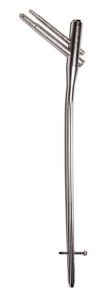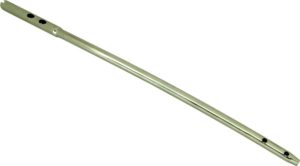ILN Interlocking nail, the most implant used for fixation of diaphyseal fractures of long bones, which has made the non-locking nail (e.g., K nail) almost obsolete despite its lower cost, simple technique, and less instrumentation
Locking done by inserting screws from one cortex through holes in the nail up to the opposite cortex. When this done proximal and distal to the fracture, it ensures rotational stability, and also maintains length. At least 2 holes present at the proximal and distal ends of the interlocking nail for screw insertion.
Suitable bones for ILN tibia, femur, and humerus. Midshaft radius/ulna fractures, also amenable to ILN.
Indications of Interlocking nail
Closed fractures of the shaft, which are not very close to the joints (for the femur, its ideal when the fracture is between the lesser trochanter and condyles)

Pathological fractures
Non-Unions and pseudoarthrosis
Malunions and deformities
Open fractures up to Gustillo III A
Uses of Interlocking nail
- Arthrodesis of the knee joint with a long femur tibia nail
- Limb-Lengthening over ILN, using an additional external fixator
Closed vs open nailing
Closed nailing means where the fracture site is not opened during operation, and the nail is inserted antegrade and percutaneously. It is the method of choice since it retains periosteal vascularity and reduces infection. However, if the acceptable reduction is not possible, open reduction followed by antegrade nailing may be considered, but non-union and infection rates are much higher for open nailing.
Reamed vs Unreamed nailing
Advantages of reaming
- Larger diameter nail (thus stronger implant)
- Bone dust produced by reaming acts like bone graft, with the osteoinductive property
- Nail insertion becomes a quick, easy, and smooth procedure.
Disadvantages of reaming
Destroys endosteal vasculature and cause necrosis of the inner cortex.
The heat generated and raised intramedullary pressure increases the chances of fat embolism
In open fractures, reaming may disseminate contamination/infection
Advantages of ILN
Early mobility/ambulation of the patient reduces post-operative complications
Provides rotational stability in a load-sharing implant. (Remember –plates are load-bearing implants)
Disadvantages of ILN
Needs specialized fracture table and C-arm image intensifier. Which increase the cost
Needs expertise which comes with a steep learning curve
Dynamization
 When locking screws present only at one end of the nail, called dynamization. Commonly the shorter fragment kept locked. It permits compression at the fracture site, which is beneficial in delayed unions. Since static locking (screws at both ends) uniformly achieves good union, routine dynamization not practiced/advocated.
When locking screws present only at one end of the nail, called dynamization. Commonly the shorter fragment kept locked. It permits compression at the fracture site, which is beneficial in delayed unions. Since static locking (screws at both ends) uniformly achieves good union, routine dynamization not practiced/advocated.